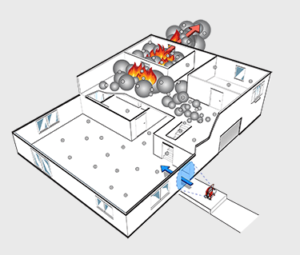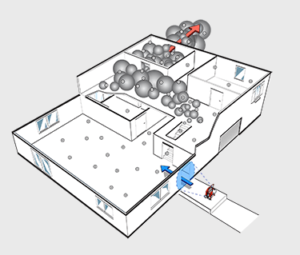Firefighting
The fire industry is what started it all for Tempest and positive pressure ventilation/attack (PPV/PPA). Working alongside a number of innovative fire departments in California, we were involved in supplying the first ventilators used in the initial testing of PPV/PPA. Since that time, we’ve become well known as the leading supplier for quality, American-made positive pressure ventilation fans used all over the world. We take tremendous pride in our origins and owe much, if not all of our success, to our wonderful firefighting customers.
Safely Expelling Heat, Gas And Smoke
While the thought of introducing fresh air to a fire may seem counter-intuitive, positive pressure attack (PPA) sees its greatest success by simultaneously removing two other necessary elements of fire production, heat and fuel (smoke), counter-acting any initial danger experienced by the introduction of fresh air. Of course, venting a fire, especially a ventilation limited fire, will increase fire growth if enough time is permitted. Yet this is not a concern as firefighters are now able to find, reach and attack the fire much more rapidly once PPA is initiated. With PPA, firefighters enter a structure standing, not crawling, with clear visibility and in dramatically lower temperatures and reduced levels of hot fuel (smoke).
Reducing Exposure To Deadly Airborne Toxins

PPA and PPV are often used synonymously with one another, however, there is an important yet simple difference. Positive Pressure Attack (PPA) is the use of positive pressure during the attack phase, or before the fire has been knocked down. Positive Pressure Ventilation (PPV), the more commonly used tactic of the two, is the use of positive pressure after the fire has been extinguished. Like PPA, PPV is a much more effective and efficient means of ventilation over its predecessors. Nearly all fire departments in the US utilize PPV during overhaul to rid the structure of lingering smoke and harmful toxins/carcinogens still present in the air after the fire has been extinguished.
Full Breadth Of Ventilation Related Firefighting Tools
The line-up of Tempest and Leader tools used in firefighting includes not just Positive Pressure Ventilation and Attack fans but a wide array of ventilation related equipment including VentMaster® Fire Rescue Chain and Cutoff Saws, Smoke Machines, Mobile Ventilation Units (MVU®), Leader Large Flow Ventilators, Leader Nozzles, Thermal Imaging Cameras, PathMaster® Smoke Curtain & Flow Path Curtains and more. See all of our firefighting ventilation tools HERE.
PROUD MEMBERS OF:

The Original Positive Pressure Ventilator
The fire industry is what started it all for Tempest and positive pressure ventilation/attack (PPV/PPA). Working alongside a number of innovative fire departments in California, we were involved in supplying the first ventilators used in the initial testing of PPV/PPA. Since that time, we’ve become well known as the leading supplier for quality, American made positive pressure ventilation fans used all over the world. We take tremendous pride in our origins and owe much, if not all of our success, to our wonderful firefighting customers.
Safely Expelling Heat, Gas And Smoke
While the thought of introducing fresh air to a fire makes most uncomfortable, positive pressure attack (PPA) sees its success by simultaneously removing two other necessary elements of fire production, heat and fuel (smoke), counter-acting any initial danger experienced by the introduction of fresh air. Of course, venting a fire, especially a ventilation limited fire, will increase fire growth if enough time is permitted. Yet this is not a concern as firefighters are now able to find, reach and attack the fire much more rapidly once PPA is initiated. With PPA, firefighters enter a structure standing, not crawling, with clear visibility and in dramatically lower temperatures and reduced levels of hot fuel (smoke).


PPA and PPV are often used synonymously with one another, however, there is an important yet simple difference. Positive Pressure Attack (PPA) is the use of positive pressure during the attack phase, or before the fire has been knocked down. Positive Pressure Ventilation (PPV), the more commonly used tactic of the two, is the use of positive pressure after the fire has been extinguished. Like PPA, PPV is a much more effective and efficient means of ventilation over its predecessors.
Nearly all fire departments in the US utilize PPV during overhaul to rid the structure of lingering smoke and harmful toxins/carcinogens still present in the air after the fire has been extinguished.





